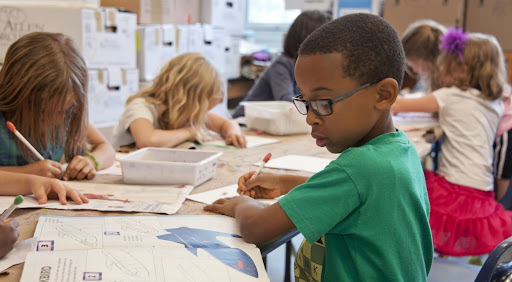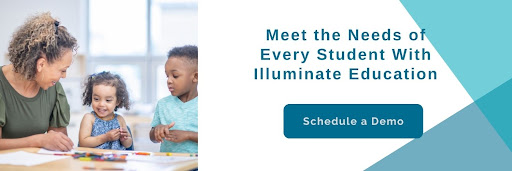How to Support Student Engagement at the Universal Tier
When students are engaged in the classroom, their academic and socio-emotional growth thrives. However, as every educator knows, supporting student engagement doesn’t necessarily come easily.
In this article, we will share evidence-based practices that help motivate and support student engagement in the universal tier.
Table of Contents
- How to Approach Student Engagement in the Universal Tier
- Evidence-Based Practices That Support Student Engagement in the Universal Tier
- How to Support Student Engagement in the Universal Tier With Remote Learning
- Meet the Needs of All Students With Illuminate Education

How to Approach Student Engagement at the Universal Tier
Finding ways to empower and engage all students in their learning is critical. As educators, there are a myriad of ways to accomplish this within the instruction we provide all learners.
The best approach to student engagement in the universal tier involves:
- Thinking about the way students talk, write, and actively participate in instruction; and
- Using evidence-based practices to encourage and promote those specific engagements
Evidence-Based Practices That Support Student Engagement in the Universal Tier
Educators regularly think about creating engaging lessons. Considering student engagement (their speaking, writing, and participation) during lesson planning can make a meaningful difference in learning. Below is a list of seven evidence-based practices that can be used to support student engagement in the universal tier:
- Relationships
- Evaluation and reflection
- Explicit teaching strategies
- Feedback
- Spaced practice
- Repeated reading programs
Let’s go into detail about each of these practices and how they can be implemented in the classroom to support student engagement.
#1: Relationships
Building relationships with students is critical in supporting student engagement in the universal tier and is highly effective. It is important to make sure that relationship-building efforts are intentional and unique to each student. We all connect naturally with some people over others. To build relationships with students who aren’t natural connections, intentional strategies can be helpful. Consider using these first with students who need additional positive adult connections the most.
Examples of This Practice
There are many ways to develop effective and meaningful relationships with students. One evidence-based way to build relationships with students is through the 2 by 10 method. This strategy involves talking with a student for 2 minutes a day for 10 school days in a row. You can talk about anything positive, including some school-related and some non school-related topics such as weekend plans, hobbies, or favorite shows. This concerted time gives both the student, and the teacher an opportunity to get to know each other and lets the student know their teacher cares about them. Here are a few examples of relationship-building strategies that can help support student engagement in the classroom:
-
-
- Greeting each student by name daily
-
Practicing frequent and regular communication about topics of interest, such as asking students about how their weekend or sports event went.
#2: Evaluation and Reflection
Allowing students to reflect upon and evaluate their own performance is an effective way to promote student learning, engagement, and improvements in performance. This practice should be formative and allow for adjustment and correction.
Examples of This Practice
Student evaluation and reflection should be both formative and learning-oriented to maintain effectiveness in supporting student engagement. Common forms of self-reflection include activities such as the one below. Students are asked to review essays they have written using a criteria rubric provided by the teacher. They are given the opportunity to revise their essays based on the criteria provided, therefore improving their performance through self-reflection.
In addition to traditional self-reflection activities, students can be asked to evaluate their work and self-reflect throughout a lesson. During a classroom writing activity where students were asked to write a persuasive paragraph, they could use a checklist after their writing to reflect and revise their work.
#3: Explicit Teaching Strategies
Explicit teaching strategies are another effective way to increase and support student engagement in the universal tier. Explicit teaching has been found to be especially effective in teaching reading and writing.
Examples of This Practice
Explicit teaching involves clearly demonstrating to students how to successfully complete a task or skill, such as writing a sentence.
Explicit teaching is achieved through the following steps:
-
-
- First, the teacher sets specific and transparent criteria for success, which are shared in detail with the students.
- The teacher demonstrates how to successfully complete the task through physical demonstration.
- The teacher periodically checks for student understanding and summarizes the process once the task is complete.
- Students are provided with instruction and materials needed to complete the task independently.
-
#4: Feedback
Feedback is a part of explicit instruction but is an evidence-based practice all on it’s own. Meaningful feedback is an effective way to deepen students’ understanding and accelerate student learning. This practice can be used throughout a lesson to encourage student engagement while enhancing student performance.
Examples of This Practice
Feedback is two-way communication between teachers and students. This allows students the opportunity to correct mistakes while still offering encouragement and praise for their efforts.It involves students providing feedback about what they know and can do (through their verbal and written responses) and teachers provide feedback about the responses to support continued learning. During a given lesson, there should be numerous times that feedback is given. For example, a teacher may be giving a vocabulary lesson. She begins by writing the word and saying the word. She asks all students to repeat it together. She listens to make sure everyone pronounces it correctly. If she hears any incorrect pronunciations, she repeats the word, and has everyone say it again.
As the lesson continues, at one point, the teacher has been sharing examples and non-examples of correct use of the vocabulary word. She has students write some examples and non-examples on white boards and share them with a neighbor. During that time, she walks around, reviews for accuracy, and can correct any right in the moment. Additionally, since students are working in pairs, they’re also getting feedback from their partner.
Throughout any lesson, both students and teachers give and receive feedback that support engagement and accelerate learning.
#5: Spaced Practice
Hundreds of studies have demonstrated the efficacy of spaced practice when it comes to student engagement, improvement, and performance.
Examples of This Practice
Spaced practice involves practicing skills in short and focused periods of time to help strengthen students’ understanding and fluency of the material taught. With whole groups, spaced practice can be used to practice skills students should have mastered, or reinforce current skills.
Here is an example of spaced practice:
A kindergarten class has a large number of students who started the fall at-risk in the area of phonemic awareness. The classroom teacher uses the recommended amount of time from the curriculum to directly teach phonemic awareness skills and also incorporates phonemic awareness activities intentionally throughout the day. Each day, he ensures that students practice phonemic awareness skills at least 5 times. This takes the form of centers activities, activities done in lines while waiting, and activities the whole class does before or after other lessons or transitions. This allows students to practice the skills often throughout the day.
#6: Repeated Reading Programs
Repeated reading programs are a highly effective whole-group intervention that can help increase students’ oral reading fluency. They are believed to be effective because they provide learners with a significant amount of extra reading practice. When done regularly, they can provide a way to encourage spaced practice in the area of reading.
Examples of This Practice
A repeated reading program can be effectively implemented by having student pairs read passages aloud several times while receiving feedback from a peer.
When a mistake is made, the correct word is provided and the student rereads the sentence.
When implemented in a whole-group setting, teachers may choose passages relevant to curricular content, such as textbook passages, articles, or stories. It is important that passages provided to students are at the students’ independent reading levels.

How to Support Student Engagement in the Universal Tier With Remote Learning
Supporting student engagement during remote learning can present different challenges than in in-person classrooms. With the ability for students to…
- Log off or step away from their computers
- Turn their screens off
- Become distracted by their environment
- And more
… student disengagement can be more prevalent and difficult to redirect compared to in-person classroom settings.
However, many evidence-based strategies can translate to remote learning and help stimulate and support student engagement during remote learning. Here are some examples of evidence-based strategies that can be implemented:
- Building relationships with students: Whether in-person or online, there are plenty of opportunities to work on building relationships and communicating with students. Whole group icebreakers can be a great way to learn more about student interests. Individual, regular messages to students can continue to build positive relationships.
- Self-reflection and evaluation: After teaching online lesson expectations, students can practice self-reflection after each lessons. Some behaviors may include:
- I was respectful in my chat messages
- I completed the work assigned during the session
- I was on-task during breakouts
- I notified my teacher if I stepped away during class.
- Explicit teaching strategies: The same instructional structure of modeling and having guided practice with feedback used during an in-person class should be used online. You may use breakout rooms for students to practice and respond in pairs, and use the chat and reactions within the platform to get frequent and regular responses.
- Spaced practice: Scheduled brief practice sessions and opportunities for students to implement paired practice with peers can be implemented in a remote learning environment.
Motivation: Reinforcement strategies can be used to motivate students to engage in their learning during class. For example, when students complete specific assignments, or participate in sessions, they may be sent a link to a session where they play games with their teacher and classmates.
Meet the Needs of All Students With Illuminate Education
Illuminate Education equips educators with data to serve the whole child and reach new levels of student performance.
Our solution brings together holistic data and collaborative tools and puts them in the hands of educators. Illuminate supports 17 million students in 5,200 schools and districts across all 50 states.
Ready to discover your one-stop shop for your district’s educational needs? Let’s talk.


